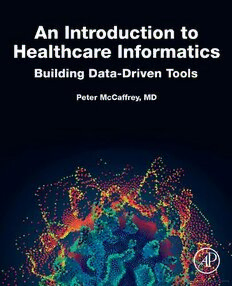Table Of ContentAn Introduction to Healthcare Informatics
An Introduction to Healthcare
Informatics
Building Data-Driven Tools
Peter Mccaffrey
AcademicPress
125LondonWall,LondonEC2Y5AS,UnitedKingdom
525BStreet,Suite1650,SanDiego,CA92101,UnitedStates
50HampshireStreet,5thFloor,Cambridge,MA02139,UnitedStates
TheBoulevard,LangfordLane,Kidlington,OxfordOX51GB,UnitedKingdom
©2020ElsevierInc.Allrightsreserved.
Nopartofthispublicationmaybereproducedortransmittedinanyformorbyanymeans,electronicormechanical,
includingphotocopying,recording,oranyinformationstorageandretrievalsystem,withoutpermissioninwritingfromthe
publisher.Detailsonhowtoseekpermission,furtherinformationaboutthePublisher’spermissionspoliciesandour
arrangementswithorganizationssuchastheCopyrightClearanceCenterandtheCopyrightLicensingAgency,canbefoundat
ourwebsite:www.elsevier.com/permissions.
ThisbookandtheindividualcontributionscontainedinitareprotectedundercopyrightbythePublisher(otherthanasmay
benotedherein).
Notices
Knowledgeandbestpracticeinthisfieldareconstantlychanging.Asnewresearchandexperiencebroadenourunderstanding,
changesinresearchmethods,professionalpractices,ormedicaltreatmentmaybecomenecessary.
Practitionersandresearchersmustalwaysrelyontheirownexperienceandknowledgeinevaluatingandusingany
information,methods,compounds,orexperimentsdescribedherein.Inusingsuchinformationormethodstheyshouldbe
mindfuloftheirownsafetyandthesafetyofothers,includingpartiesforwhomtheyhaveaprofessionalresponsibility.
Tothefullestextentofthelaw,neitherthePublishernortheauthors,contributors,oreditors,assumeanyliabilityforanyinjury
and/ordamagetopersonsorpropertyasamatterofproductsliability,negligenceorotherwise,orfromanyuseoroperationof
anymethods,products,instructions,orideascontainedinthematerialherein.
LibraryofCongressCataloging-in-PublicationData
AcatalogrecordforthisbookisavailablefromtheLibraryofCongress
BritishLibraryCataloguing-in-PublicationData
AcataloguerecordforthisbookisavailablefromtheBritishLibrary
ISBN:978-0-12-814915-7
ForinformationonallAcademicPresspublications
visitourwebsiteathttps://www.elsevier.com/books-and-journals
Publisher:Masucci,Stacy
AcquisitionsEditor:Teixeira,RafaelE.
EditorialProjectManager:Fernandez,BillieJean
ProductionProjectManager:Raviraj,Selvaraj
Coverdesigner:Hitchen,Miles
TypesetbySPiGlobal,India
To my wife, Kaytlin
To my wonderful children, Briar and Huxley
Author’s biography
PeterMcCaffrey,MD,isaphysicianinformaticistwhocurrentlyservesasbothCo-Founder
and Chief Technology Officer at VastBiome, a computational drug discovery company
investigatingnovelcancertherapies,aswellasDirectorofPathologyInformaticsandDirector
ofLaboratoryInformationSystemsatTheUniversityofTexasMedicalBranch.Dr.McCaffrey
attendedmedicalschoolatTheJohnHopkinsUniversitySchoolofMedicineandcompletedhis
Residency and Chief Residency in Clinical Pathology and Laboratory Medicine at Harvard
Medical School and Massachusetts General Hospital. In addition to his current roles, Dr.
McCaffreyhasalsopreviouslyservedasCo-FounderandChiefTechnologyOfficerofHadera
Technologies, where he led the development of several production healthcare applications
focusing on streaming data analysis and predictive analytics as well as Founder and CEO of
Accetiawherehisteamfocusedonbuildingcloudplatformsfortheanalysisofnext-generation
sequencingdata.Dr.McCaffreyhasworkedwithhospitalsinMassachusetts,Texas,California,
and overseas in project areas ranging from application development to analytics, application
architecture, and IT project management.
xiii
Foreword
To say that healthcare is rapidly evolving is an understatement. At the time of this writing,
there are several disruptive forces presently changing the nature of this field not to mention
several even moreimpactfulonespreparing to doso.Whether it be the potentialfor artificial
intelligence to triage medical images or even render diagnoses from them, the ability to
predict hospital complications days in advance, the ability to unify patient data across the
continuum of care, or even the ability to know how many patients present to an emergency
departmentonadailybasis,locatingdataandutilizingthemtosolveproblemsisfastbecoming
a core competency for the healthcare workforce. This would, of course, not be the first time
that healthcare has witnessed the growth and development of new forms of professional
value as it intersects with a technological domain. For example, my own field of pathology
wascreatedthroughtheintegrationofmicroscopyintomedicalscienceandtheformalizationof
microscopic imaging as a diagnostic tool and then further evolved through the advent of
genomics and molecular testing.
Atpresent,healthcareisfindingdatamoreeasilyavailableanditsanalyticalusesmorerealistic
and enticing. This is further supported by growth in parallel sectors producing ever newer
and more powerful database technologies, large-scale data processing frameworks, analytics
tools, and artificial intelligence applications. Amidst all of this, we see the concept of the
healthcare data scientists and informaticists becoming more and more tangible as these
skills move from the domain of research and recreational interest to that of primary role and
central focus. This book, therefore, aims to outline the skills and concepts upon which these
roles are—and will be—built and to unite both technical and healthcare subjects into one
cohesive core. The following 21 chapters are at times applied and at times theoretical, but
they all focus on enabling readers to understand how to collect and analyze data in the
healthcare setting. Equally important, this book aims to match its general curricular
elementswithadviceandbestpracticegroundedinmyexperiencebuildingdata-driventoolsin
hospitals. Lastly, Chapters 4 and 17 contain projects that solidify database, programming,
and analysis concepts by walking through their application to healthcare problems.
If anything, it is my hope that this book serves merely as the beginning of a career-long
commitment to continued learning and skill building in the pursuit of ever more useful,
efficient, and insightful analysis and a deeper understanding of hospitals, healthcare systems,
xv
Foreword
and patient care. These are exceptionally exciting times to be in the healthcare field as there
are so many opportunities to innovate and improve through the use of healthcare’s growing
data footprint. By deciding to read this book, you have already taken a first step toward
this exciting future. As you progress through the chapters that follow, I encourage you to
think about how each concept and skill can enable you to solve problems currently facing
youandyourinstitutionandtocrystallizethoseconceptsthroughexperimentationbyapplying
them to those projects and problems of your own.
xvi
CHAPTER 1
The healthcare IT landscape
1.1 How we got here and the growth of healthcare IT
Asamemberofthemodernhealthcareworkforce,technologyseemslikeaninextricablepartof
the clinical experience. For many, interacting with the myriad components of healthcare
technologycanrepresentanonerousaspectofclinicalworkandtheblameforsuchburdensome
interactionsiscommonlyplacedonITdepartmentsandhospitalmanagementasbeingwoefully
out of touch with providers on the front lines. While this certainly bears some truth, there is
much more to the story of how healthcare IT has evolved. In this section, we will discuss the
developmentalhistoryofmodernhealthcareITwiththegoalofunderstandingofthedynamics
that have shaped its current incarnation.
Withoutreachingbacktoofarinthehistoryofhealthcare,itcanbesaidthatmuchofthedeep
historyofmedicalpractice(mainlythatprecedingthelate19thcentury)waswithoutacentral
organizing force.1 Professional and intellectual societies certainly offered a central space for
aggregating and sharing knowledge of diagnostic and treatment practices, and yet healthcare
remainedlargelyacottageindustryofindividualpractitioners.ClinicalluminariessuchasDr.
WilliamOslercertainlyimproveduponthisstateofpersonalized,artisanalmedicinebyleading
inthedevelopmentofmoreconsistentandrobusttrainingprocessesintheformoftheclinical
residency,theroutineuseoflaboratorytesting,andtheestablishmentofroutineclinicalrounds
but,still,theprofessionalimplementationofhealthcarewassituatedmainlyinthesmallclinic
and placed within the hands of the expert individual.2
Theadventofmodernhealthinsurance,however,representedadeeplytransformativeforcein
healthcare.Althoughtherehadbeeninsuranceproductsfocusedondisabilityandcoveragefor
accidents,itwasnotuntilthe1920sthathospitalsbeganofferingpaymentplansthroughwhich
patients could cover medical expenses themselves. These hospital-based policies quickly
becameaggregatedintothefirstBlueCrossorganizationsinthe1930s.ThesecondWorldWar
accelerated the growth of structured medical expense coverage as the wage freeze drove
employers to create and offer employer-sponsored health benefits as a means of attracting
employees.3 This was mirrored in a Federal effort to provide such coverage benefits to those
without employer-sponsored or private plans, leading to the development of Medicare in the
mid-1960s.4 Further maturation of insurance instruments brought about more complex
AnIntroductiontoHealthcareInformatics.https://doi.org/10.1016/B978-0-12-814915-7.00001-6
#2020ElsevierInc.Allrightsreserved. 3

